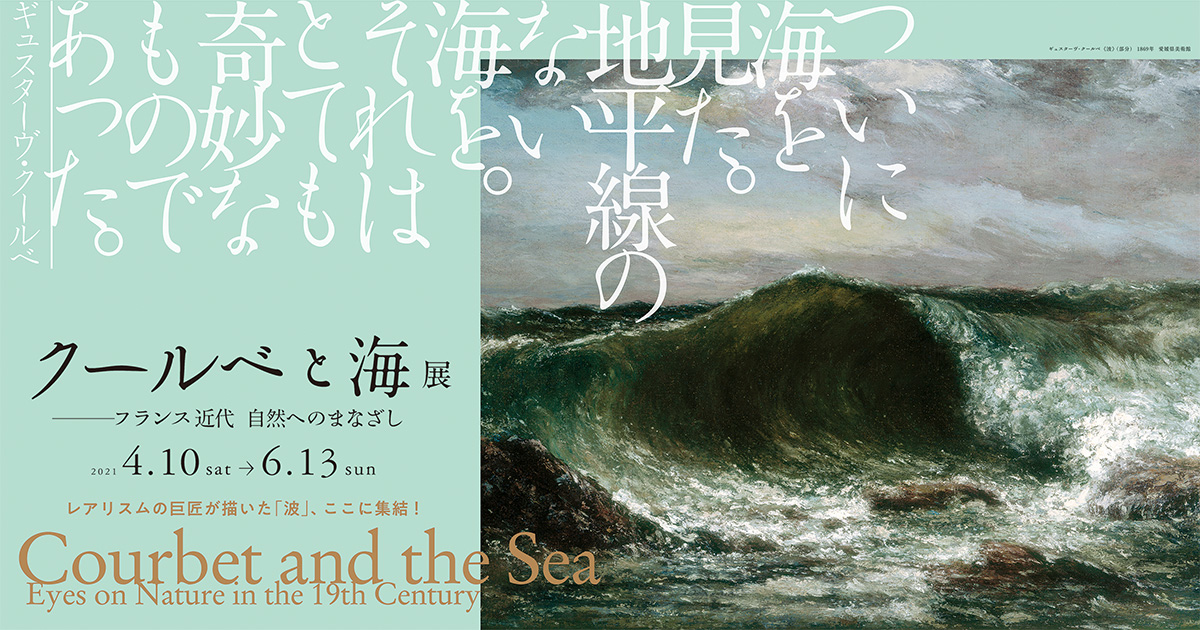Courbet and the Sea: Eyes on Nature in the 19th Century

To those who wish to visit the Courbet and the Sea: Eyes on Nature in the 19th Century exhibition
To prevent the spread of COVID-19, we would like to request that you reserve the date and time of your visit in advance from our reservation website.
All advance reservations are no longer accepted.
- The admission fee is to be paid upon your visit.
- We are not accepting reservations by phone or at the museum reception.
General Information
- Dates
- Apr. 10 - Jun. 13, 2021
- Hours
- 10 a.m. – 6 p.m. (Admittance until 5:30 p.m.)
* Open until 8 p.m. (admittance until 7:30 p.m.) on May 7 and June 4.
[Notice of reopening]
We will reopen from June 1 and the opening hours will be as follows.
1 (Tue) -4 (Fri) 10: 00-18: 00 (Open on Wed)
5 (Sat) and 6 (Sun) 9: 30-19: 00
7 (Mon) -11 (Fri) 10: 00-19: 00 (Open on Wed)
12 (Sat) and 13 (Sun) 9: 30-19: 00
The night opening scheduled for June 4 will be cancelled.
- Closed
- Wednesdays (Except for May 5)
- Admission
- Adults: ¥1000
Visitors aged 65 or over carrying proof of age: ¥900
Students (College): ¥700
Students (High / Middle school): ¥500
Admission is free for children in primary school and younger.
Admission is free for disability passbook holders and up to one accompanying adult.
- Organizers
- Panasonic Shiodome Museum of Art, The Yomiuri Shimbun, The Japan Association of Art Museums
- Sponsors
- Lion Corporation, Dai Nippon Printing Co., Ltd., Sompo Japan Insurance Inc.
- Supporters
- Embassy of France in Tokyo / Institut français du Japon, Minato City Board of Education
- Cooperation
- Japan Airlines Co., Ltd., Uminomanabi Museum Support from the Museum of Maritime Science
Exhibition overview
Gustave Courbet (1819-1877) was one of the finest masters of the Realism movement in 19th century France. Courbet rejected the existing political and artistic institutions of his time, instead choosing to paint truthful and unidealized depictions of the world around him. Nevertheless, he drew high praise for the keen attention to detail and exceptional skill apparent in his many portrayals of the wilderness and fauna in his home region of Franche-Comté, as well as the sea of Normandy, on which he first laid eyes at the age of 22.
Courbet's work as a landscape painter takes center stage in this exhibition, with a particular focus on a series of paintings titled The Wave that he began in the 1860s. Courbet and the Sea explores the distinctive characteristics of the seascape paintings by Courbet, produced during a time when the sea was becoming ever more accessible. To add context, the exhibition also showcases paintings from before Courbet's time that depict the sea as an object of reverence, as well as paintings of the sea as a leisure destination by Courbet’s contemporaries such as Eugène Boudin and Claude Monet.
The approximately 60 pieces in this exhibition include works belonging to collections around Japan, as well as The Wave from the collection of the Musée des Beaux-Arts d’Orléans in France. Visitors are invited to enjoy Courbet's depictions of the mighty ocean in a style that was seen as particularly “odd”—to borrow Courbet’s first impression of the ocean—when considered among other seascape paintings from the same period.
*Some pieces will be rotated midway through the exhibition period, with the first rotation running from April 10 to May 11 and the second from May 13 to June 13. Further information will be published on our website.





